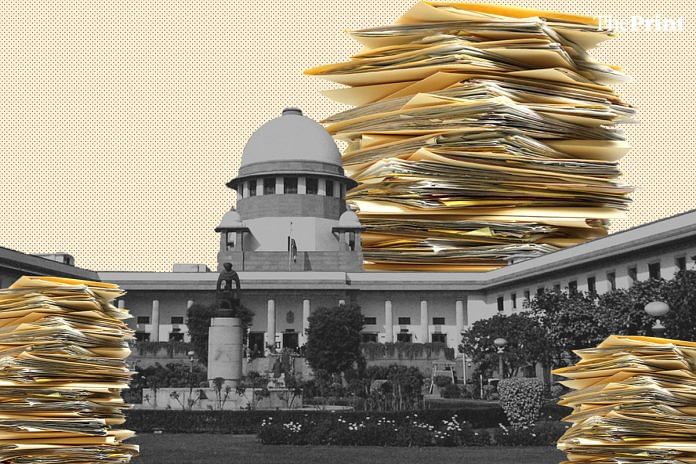It took the Supreme Court nearly 500 pages to decriminalise homosexuality in the Section 377 verdict. The judges quoted heavily from Shakespeare, John Stuart Mill, Wilde and Goethe among other writers and philosophers.
ThePrint asks– Supreme Court’s nearly 500-page order on Sec 377: Are India’s judges most erudite or too verbose?
US Supreme Court judgments went from 2000 words in ‘80s to 8000 words in 2016, UK judges write 30-40 pages
 Sudhir Krishnaswamy
Sudhir Krishnaswamy
Professor, Azim Premji University
H.L.A. Hart, professor of jurisprudence at Oxford University paraphrased Henry James to compliment his predecessor Arthur Goodhart in this way: “Even when he is clearly wrong he is wrong clearly.” Hart elevated concision and clarity as the primary virtue in legal thought and writing and often showed up verbosity and prolix writing to be efforts at obfuscation.
However, in the last five decades since the epochal Supreme Court decision in the Kesavananda case, which occupied almost 500 pages of the court reporter, our Court judgments routinely cross the 200-page mark. While Kesavananda’s excesses may be explained as statecraft designed to confuse and befuddle a political class to not recognise the diminution of their powers, it has inadvertently led to the conflation of the length of a judgment with its profundity.
The rapid development of word processing and digital copying technologies, together with the ubiquity of internet resources and the introduction of student law clerks has brought this mode of judicial production within the reach of every judge. Now even when all five judges agree on the outcome in the Section 377 case, they collectively need not less than 400 pages to do so.
Moreover, this prolixity is not a special demand of the legal tradition we’ve inherited. Political scientists complain that the US Supreme Court has moved from a median word length of 2,000 words in the 1980s to nearly 8,000 words in 2016. On average the Supreme Court of the UK writes 30-40 pages in each case.
So, if neither statecraft nor the legal tradition demands such verbosity, we must implore our judges to invite with clear and concise prose, the approximately 30 per cent of Indians who can modestly access the English language, to vital public debates at the core of a republican society.
Future lawyers and judges will struggle to understand what court actually decided in important cases
 Alok Prasanna Kumar
Alok Prasanna Kumar
Senior resident fellow, Vidhi Centre for Legal Policy
The content notwithstanding, the Navtej Johar judgment is yet another indication of the increasing verbosity of the judgments of the Supreme Court of India. I say verbosity in two senses: the length of the judgment and the fact that more judges are writing concurring opinions without saying anything new or different from the rest.
This has been happening too often in recent times. Six concurring opinions were rendered in the Puttaswamy case. Three in the LG-AAP case. Four in the case concerning living wills. Nothing fundamentally different was said by the concurring judges except for a minor semantic difference in these cases. Certainly, none of the concurring opinions will go down in history for having shaped the law in the way Justice V.R. Krishna Iyer’s or Justice O. Chinappa Reddy’s have.
The danger of this is two-fold: critical engagement with the judgments will decrease, and future lawyers and judges will struggle to make sense of what the court actually decided in important cases. The clever lawyer will be able to pick and choose from large reams of text to build entirely different and contradictory arguments, lessening the law’s strength.
It’s not enough to say that judges should be more concise without addressing the underlying causes – increasing pressure and workload. Good writing is usually a function of time and effort, and demanding that judges turn out perfect prose and reasoned judgments while having to make a dent on the mountain of backlog is unrealistic. Verbosity and diffusion of opinions is just the symptom of the deeper underlying problem – the Supreme Court as an institution has lost sight of its mission and importance as the apex constitutional court of India.
Also read: Supreme Court has earned moment of rest with 377 verdict, but much remains to be cleared
Long Supreme Court judgments may deter efforts to translate them into regional languages
 K.V. Dhananjay
K.V. Dhananjay
Advocate, Supreme Court
Our team undertook a study in 2014 to identify the proportion of our Supreme Court judgments that involved a constitutional question.
Of the 884 judgments delivered that year, less than 7 per cent did.
And, our task was made very difficult by the fact that our Supreme Court has been writing too much in its judgments over the past few years and it has our jurists seriously worried. Consequently, more judicial time must be devoted in courtrooms across the country to go through the increasingly voluminous judgments of our Supreme Court. In turn, it would lead to even more voluminous judgments from the Supreme Court to simply address its previous volume, leading to more judicial delays and confusion.
While nobody would doubt the monumental nature of the 377 verdict, the judgment in itself is very long. There may not even be enough persons in the legal fraternity, who aren’t involved in this particular case, who would be keen to read it in its entirety.
Our Supreme Court judges who write large volumes might do well to ask themselves if there is even a good enough audience for their writings. And do these long judgments pre-empt more questions and doubts on the ground? For instance, take sex between three consenting adult men, or women, or a mix of them. Is it also protected by this judgment or, it only protects sex between two consenting adults of the same sex? Please read the judgment in entirety for the answer.
The sheer volume would also deter any enthusiasm by some people to translate our Supreme Court judgments into regional languages. So, it is apt, at this hour, to ask for shorter judgments from our Supreme Court.
Most judges reproduce portions of previous judgments mechanically, technology can help
 Apurva Vishwanath
Apurva Vishwanath
Special correspondent, The Print
Judicial rulings do tend to be verbose, complicated and sometimes difficult to understand. Judgments run into hundreds of pages and sometimes are filled with observations of judges that do not form the ratio or the part of the judgment that is considered binding.
A judge is required to pass speaking orders that explain the reasons for his/her decision so there is no element of doubt or confusion.
In India, a typical judgment follows this structure: A recital of facts of the case, arguments made by both sides, all case laws that are related to the issue, the judge’s analysis and conclusion.
Most judges reproduce portions of previous judgments mechanically. Technology can help with this problem. For example, live streaming of proceedings will ensure arguments of counsels need not be reproduced in the judgment.
That said, the Section 377 judgment decriminalising is not a fit case to examine this issue. A reference made to a larger bench to interpret a colonial law against fundamental rights of the constitution obviously requires more than a mechanical yes or no answer.
The Section 377 ruling and similar ones like last year’s landmark privacy ruling (547 pages) must be exceptions because these are written to develop the law. They are not cases where the court examines a set of facts and decides if a crime has been committed or if a right has been violated. These rulings are in abstract, evolving rights that were previously unrecognised. The purpose of larger bench rulings is to ‘settle’ the law. Such elaborate rulings by larger benches will ensure that answers are found by smaller benches to many constitutional questions that may crop up in future.
Compiled by Fatima Khan, journalist at The Print. You can follow her on twitter @khanthefatima.







Brevity is the essence of wit- so goes a proverb. Whether wit automatically translates to wisdom is not known. But I believe this verbosity in judgments is only to overawe the masses. I doubt if anybody other than who feel deprived of justice in a particular case would look at anything more than the executive part of the order.
Btw, I have noticed a peculiar similarity with most judgements. The begin with grand standing with quotes like ‘be you ever so high the law is above you, blah, blah,blah’, the facts are recorded almost correctly, the conclusions drawn are questionable and the decisions? Out of this world!
I love and admire the apex court, am an unabashed fan, lekin kabhi kabhie dil mein yeh khayal aata hai ki Their Lordships seem to love giving hours of dictation to their stenographers. A separate judgment is normally delivered when a judge dissents from the majority view. History shows that the minority view sometimes is a repository of greater wisdom and erudition. When five judges are unanimous in their view, a common, pithy judgment would be wonderful. A few paragraphs, each representing different routes of reaching the shared destination, could reflect the contribution of each learned member. A grateful nation simply moves on to the operative part, like the Roman emperor’s thumbs up or thumbs down which decided the fate of a brave gladiator.